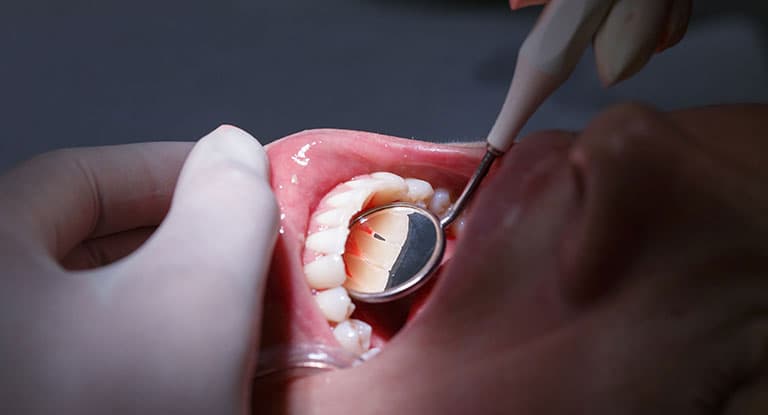.jpg)

Gum recessions are a common dental problem, it is not obvious like other dental problems, and most people do not know they have it as it develops gradually without your knowledge.
2.0 What are the causes of receding gums?
2.1 Piercing the lips or tongue
2.2 Misaligned bite or crooked teeth
2.3 Clenching and grinding your teeth
2.4 Tobacco products
2.5 Hormonal changes
2.6 Poor dental care
2.8 Your genes
3.0 How is gum recession treated?
4.0 What Type Of Surgery Is Used In Treating In Gum Recession?
4.2 Regeneration
4.3 Root planning and open flab scaling
5.0 How Can I Prevent Gum Recession?

Gum recession is a condition whereby the margin of the gum tissues surrounding the teeth weakens, pulls back, wears away — exposes most of the tooth or the root of the tooth.
Gum recession leads to gaps or pockets which form between the teeth and gum lines. This makes it easy for harmful bacteria that cause diseases to build-up and cause problems in the mouth.
If this condition is not treated, the gums, bone structures, and supporting tissues of the mouth will be damaged severely. It can gradually lead to serious dental problems like tooth loss.
Tooth sensitivity is one the first sign of gum recession, the tooth will also look more prolonged than usual, and a notch will be felt near the gum line.
You should never ignore gum recession, call 020 71834091 to book an appointment with our dentist immediately if your gums are receding — visit us at Harley Street, London.
There are available treatments that can repair your gums and prevent further damages that can be fatal.
A few numbers of factors can make your gums to recede, and some of them are:
Jewelleries can irritate when they rub on the gum; the irritation can get to the point where the gum starts wearing away.
When the teeth are not arranged evenly, a lot of force and pressure will be applied on your gums and the bones beneath your gums. This will lead to gum recession.
Grinding or clenching your teeth will place a lot of force on the teeth and can make the gum to recede.
People who use tobacco are more prone to having sticky plaque on their teeth; this plaque is often difficult to remove and with time, it can cause gum recession.
In women, fluctuations in the levels of hormones during their lifetime like puberty, pregnancy — menopause can make the gums more sensitive. Therefore, making the gums prone to recession.
Poor dental, insufficient brushing of the teeth, flossing—rinsing with antibacterial mouthwash makes it easy for plaque to form on the teeth. This plaque later turns into tartar (calculus). Tartar is a hard substance that builds on your teeth and in between your teeth. Professional dental cleaning conducted by a dentist is the only way to remove this type of plaque, and if it is not done early, it can lead to gum recession.
Visit Smile Works Dental on Harley Street, London to have your dental cleaning done by our experienced dentist or call 020 71834091 to book an appointment today.
Aggressive tooth brushing can cause gum recession. Brushing your teeth too hard or do it in the wrong way, it can damage your enamel and make it wear away. It also makes your gum to recede.
Some individuals are more prone to gum recession than others, and this is due to their genetic disposition. Research shows that 30% of the population may be prone to gum recession irrespective of their proper dental hygiene.
These are the infections of the gums caused by bacteria; they destroy the tissues of your gum and the supporting bones which hold your teeth in place. This is one of the leading causes of gum recession — gum disease.
Mild gum recessions are treated by carrying out a deep cleaning on the affected area. During this deep cleaning, the plaque and tartar built on the teeth and the root surface below the gum line over the years will be removed carefully.
Then, the area of the root that is exposed is smoothed, and this makes it difficult for bacteria to attach itself to the gum. This deep cleaning is also known as root planing or tooth scaling. Antibiotics will be given to you to kill the remaining harmful bacteria.
In some cases, your dentist may recommend gum surgery. This is done when your gum recession can not be treated with deep cleaning. This occurs if there is excess loss of bone and the pockets formed are too deep. This gum surgery repairs these damages caused by the gum recession.
The following surgical procedures can treat gum recession:
This is also known as a gum tissue graft, and there are several procedures for this. The most commonly used method is the connective tissue graft. In this procedure, the dental team will cut a flab of skin at the palate (the roof of the mouth) and the tissue from under the flab; this is called the subepithelial connective tissue.
It is removed and stitched to the tissues of gum that surrounds the exposed root. After the graft, the connective tissue has been removed from under the flab and stitched back down.
Another type of graft is the free gingival graft, the tissue used is taken directly from the roof of the mouth and not under the skin, and if you have enough gum tissues around the affected tooth, the dental team will graft the gum the tooth and not take tissues from the palate. This is called a pedicle graft.
This procedure is carried out if the disease has destroyed the bone supporting your teeth. The dental team will fold back the gum tissue and remove the bacteria.
Regenerative materials such as a tissue-stimulating protein, a graft tissue — a membrane are applied, this will encourage the body to regenerate bone and tissue naturally in that area.
After the regenerative material has been applied, the tissue of the gum is secured over the roof of the tooth or teeth.
This procedure is carried out to eliminate pockets or reduce their sizes. The dental team will fold back the gum tissue that is affected and remove harmful bacteria from the pockets. Then the gum tissue will be secured in place over the root of the tooth. The treatment method used on you will be the best solves your dental problem.
Taking proper care of your mouth is the best way to prevent gum recession. Brush and floss your teeth daily — see a dentist at least twice a year or as recommended by your dentist.
You might be asked to see a dentist more often if you have gum recession, use a soft-bristled brush in brushing your teeth — your dentist should be able to show you the best way to brush your teeth.
If your gum recession is caused by teeth grinding or misaligned bite, your dentist will tell you how to correct the problem.
Other effective ways you can prevent gum recession are:
When you do these, your teeth will be well taken care of, and you will have a healthy smile.